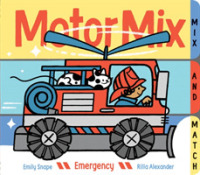Full Description
The sixth edition of Criminological Theorybuilds on its prior success with updated coverage of criminological theory and a fresh look at policy implications.The new edition continues to offer a rich introduction to how scholars analyze crime in a clear, accessible text which moves readers beyond commonsense knowledge of crime to a deeper understanding of the importance of theory in shaping crime control policies. This thoroughly revised edition covers traditional and contemporary theory within a larger sociological and historical context.New to This Edition:Expanded coverage biosocial criminology that explores the latest research in this area and the perspective's growing policy implications.New tables that summarize theoretical developments and that can serve as useful study guides Comprehensive coverage of macro-level control theories, including collective efficacy theory, the systemic model, and cultural attenuation theoryDiscussions of new theoretical developments, including male peer support theory, a theory of African American offending, integrated cognitive antisocial potential theory, and social concern theory.?Expanded coverage of new directions in critical theoryNew sources that assess developments within, and the empirical status of, the major theories Updates of crime control policies and their connection to criminological theory. Selected entries on the student study site from the Cullen/Wilcox, Encyclopedia of Criminological Theory
Contents
PrefaceAcknowledgmentsCHAPTER 1: The Context and Consequences of TheoryTheory in Social ContextTheory and Policy: Ideas Have ConsequencesContext, Theory, and Policy: Plan of the BookConclusionFurther ReadingsCHAPTER 2: The Search for the "Criminal Man"SpiritualismThe Classical School: Criminal as CalculatorThe Positivist School: Criminal as DeterminedThe Consequence of Theory: Policy ImplicationsConclusionFurther ReadingsCHAPTER 3: Rejecting Individualism: The Chicago SchoolThe Chicago School of Criminology: Theory in ContextShaw and McKay's Theory of Juvenile DelinquencySutherland's Theory of Differential AssociationThe Chicago School's Criminological LegacyControl and Culture in the CommunityAkers's Social Learning TheoryThe Consequences of Theory: Policy ImplicationsConclusionFurther ReadingsCHAPTER 4: Crime in American Society: Anomie and Strain TheoriesMerton's Strain TheoryStatus Discontent and DelinquencyThe Criminological Legacy of "Classic" Strain TheoryAgnew's General Strain TheoryA Theory of African American OffendingCrime and the American Dream: Institutional-Anomie TheoryThe Market Economy and CrimeThe Future of Strain TheoryThe Consequences of Theory: Policy ImplicationsConclusionFurther ReadingsCHAPTER 5: Society as Insulation: The Origins of Control TheoryForerunners of Control TheoryEarly Control TheoriesReckless's Containment TheorySykes and Matza: Neutralization and Drift TheoryControl Theory in ContextFurther ReadingsCHAPTER 6: The Complexity of Control: Hirschi's Two Theories and BeyondHirschi's First Theory: Social Bonds and DelinquencyHirschi's Second Theory: Self-Control and CrimeThe Complexity of ControlThe Consequences of Theory: Policy ImplicationsConclusionFurther ReadingsCHAPTER 7: The Irony of State Intervention: Labeling TheoryThe Social Construction of CrimeLabeling as Criminogenic: Creating Career CriminalsThe Consequences of Theory: Policy ImplicationsExtending Labeling TheoryConclusionFurther ReadingsCHAPTER 8: Social Power and the Construction of Crime: Conflict TheoryForerunners of Conflict TheoryTheory in Context: The Turmoil of the 1960sAdvancing Conflict Theory: Turk, Chambliss, and QuinneyConflict Theory and the Causes of CrimeConsequences of Conflict TheoryConclusionFurther ReadingsCHAPTER 9: The Variety of Critical TheoryModernity and PostmodernityPostmodern Criminological Thought: The End of Grand Narratives?Looking Back at Early British and European InfluencesEarly Left RealismThe New Criminology RevisitedLeft Realism TodayChanging Social ContextNew Directions in Criminological Theory: Death and the Birth of New IdeasThe New European CriminologyGreen CriminologyCultural CriminologyConvict CriminologyConclusionFurther ReadingsCHAPTER 10: The Gendering of Criminology: Feminist TheoryBackgroundPrefeminist Pioneers and ThemesThe Emergence of New Questions: Bringing Women InThe Second Wave: From Women's Emancipation to PatriarchyVarieties of Feminist ThoughtThe Intersection of Race, Class, and GenderMasculinities and CrimeGendering CriminologyPostmodernist Feminism and the Third WaveConsequences of Feminist Theory: Policy ImplicationsConclusionFurther ReadingsCHAPTER 11: Crimes of the Powerful: Theories of White-Collar CrimeThe Discovery of White-Collar Crime: Edwin H. SutherlandOrganizational CultureOrganizational Strain and OpportunityDeciding to OffendState-Corporate CrimeConsequences of White-Collar Crime Theory: Policy ImplicationsConclusionFurther ReadingsCHAPTER 12: Bringing Punishment Back In: Conservative CriminologyContext: The United States of the 1980s and Early 1990sVarieties of Conservative TheoryCrime and Human Nature: Wilson and HerrnsteinCrime and The Bell Curve: Herrnstein and MurrayThe Criminal MindChoosing to Be Criminal: Crime PaysCrime and Moral PovertyBroken Windows: The Tolerance of Public DisorganizationConsequences of Conservative Theory: Policy ImplicationsConclusionFurther ReadingsCHAPTER 13: Choosing Crime in Everyday Life: Routine Activity and Rational Choice TheoriesRoutine Activity Theory: Opportunities and CrimeRational Choice TheoryPerceptual Deterrence TheorySituational Action TheoryConclusionFurther ReadingsCHAPTER 14: The Search for the "Criminal Man" Revisited: Biosocial TheoriesEvolutionary Psychology: Darwin RevisitedSocial Concern Theory: Evolutionary Psychology RevisitedNeuroscience: Neurological and Biochemical TheoriesGeneticsConclusionFurther ReadingsCHAPTER 15: New Directions in Biosocial Theory: Perspectives and PoliciesBiosocial Risk and Protective FactorsEnvironmental ToxinsThe Consequences of Theory: Policy ImplicationsConclusionFurther ReadingsCHAPTER 16: The Development of Criminals: Life-Course TheoriesIntegrated Theories of CrimeLife-Course Criminology: Continuity and ChangeCriminology in Crisis: Gottfredson and Hirschi RevisitedPatterson's Social-Interactional Developmental ModelMoffitt's Life-Course-Persistent/Adolescence-Limited TheorySampson and Laub: Social Bond Theory RevisitedRethinking Crime: Cognitive Theories of DesistanceThe Consequences of Theory: Policy ImplicationsConclusionFurther ReadingsReferencesAuthor IndexSubject IndexAbout the Authors







